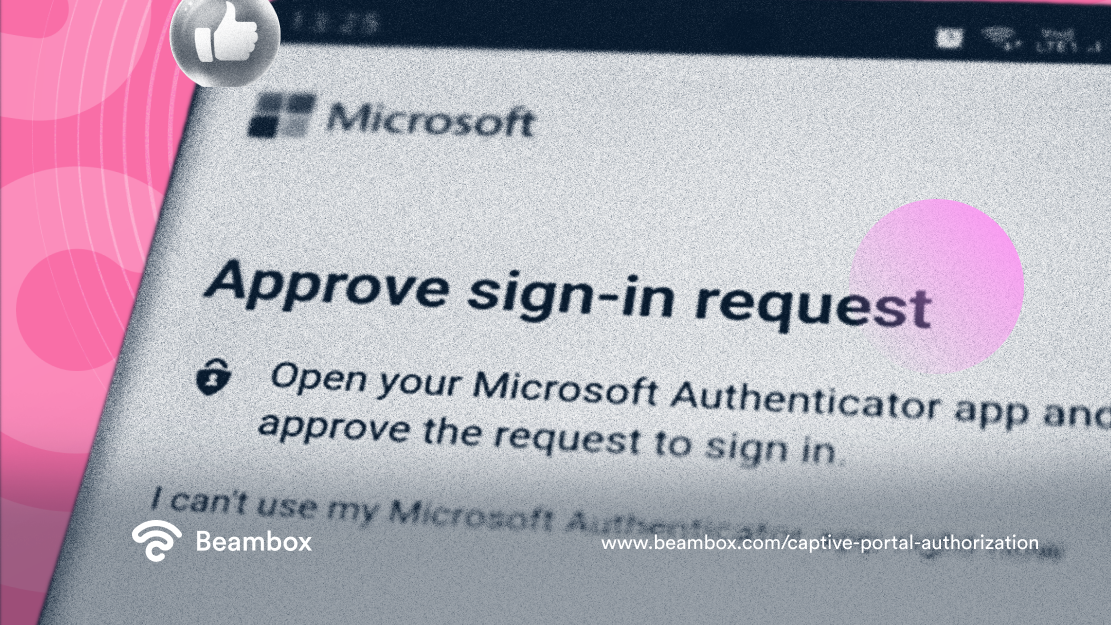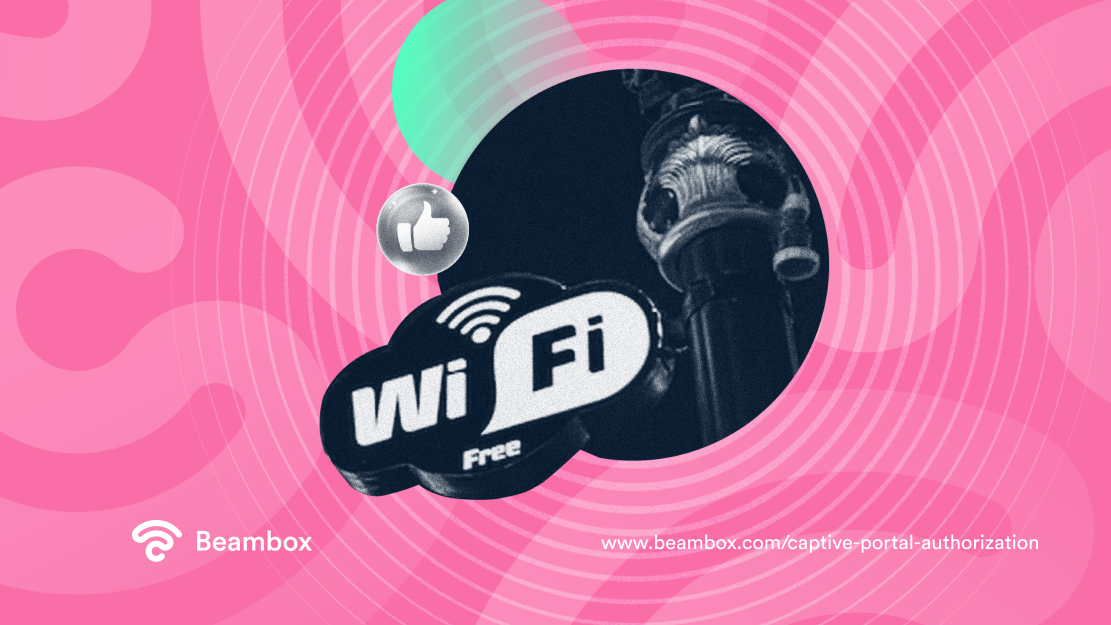A user logs in to a public WiFi network and gets redirected to a web page that asks them to agree to a user agreement. The page shows them an ad, or requires an email address or mobile number.
The web page is referred to as a “captive portal.” The “task” a user has to complete to gain access to the internet is “captive portal authorization.” Let’s break down how captive authorization works and the many ways it can be used.

Captive Portal Basics
A captive portal is a landing page or log-in page that users are redirected to when they first connect to a public or guest WiFi. The WiFi administrator often sets up captive portal authorization to require some form of interaction with users before they are granted access to the WiFi network.
The captive portal is used to verify the identity of a user via their mobile number or authorized log-in credentials. It collects other user information for marketing purposes or asks them to agree to a network user agreement.
For example, a user connects to a public WiFi hotspot at the airport using their phone. As soon as they connect to the WiFi, they are redirected to a page asking them to provide their mobile number. A one-time pin is sent to the registered mobile number via SMS. The user may be required to input the pin into the captive portal to complete the authorization process and gain access to the internet.
Another example is the hotels’ captive portal, which requires a guest to enter a temporary username and password. Some captive portals display ads that guest WiFi users have to click through before they can access the internet.

Captive Portal Authorization Hotspot: What Is It Used For
The purpose of a captive portal may vary depending on what is asked from the user and/or how the WiFi administrator wants to manage guest WiFi use.
A captive portal authorization hotspot is now SOP for most establishments that provide guest WiFi. Here are the most common ways it can be used:
- Captive portal authorization may require guest users to read and accept a user agreement to protect the WiFi network owner against liability.
- Captive portal authentication may block internet access until a user completes the authentication process via SMS, for example.
- A captive portal can keep an idle and hard time out. This means that a user has a minimum time limit to actively use the WiFi hotspot connection.
- Captive portal authorization can restrict access to a network to selected IP addresses or verified users.
- A WiFi administrator can use the captive portal to place bandwidth restrictions on users.
- A captive portal can be customized to give users different user authentication choices.
- A captive portal can be regularly updated with customized marketing content to generate revenue.
- A captive portal may allow local user management options.
- Captive portal configuration may allow businesses to capture guest users’ browsing behaviors or keep track of their movement within the business premises/geofence.

Captive Portal Authorization on Home WiFi Network
Consider setting up captive portal authorization on your home WiFi network if you have a lot of people connecting to your WiFi or want to control internet access and bandwidth use. Protecting your WiFi network with a password may not be enough if you’re renting out rooms or if you’re managing a property for transient lodging. A captive portal for a home WiFi network may also be useful in boarding houses, dormitories, foster homes, and the like.
Keep in mind, however, that not all routers can be set up with a captive portal. Captive portal functionality must be coded into the router firmware. Your local ISP can tell you if you can set up a captive portal with the router you have.
When configuring captive portal authorization for a home network, you’ll need a second network separate from your home network and with its own SSID (or wireless network name). This distinct network would serve as the guest network, and you will set up the captive portal on this network.
You can configure the captive portal to only grant internet access to specific individuals with the right login credentials. You can use the captive portal to restrict access to certain websites, and limit file downloads and bandwidth use. You can also set a maximum time limit for internet access.

2 Common Captive Portal Issues
Here are the most common captive portal authorization issues you or WiFi guests might encounter when accessing the internet.
1. Captive Portal Authorization Not Loading
If the problem is the captive portal authorization not loading, the reason may be any of the following:
- The person uses a VPN to mask their IP address and protect their private data. A device with a VPN won’t be able to bypass the captive portal and access the internet through the associated WiFi network. The user can either disable their VPN or find another open network that doesn’t have a captive portal.
- The device OS is not embedded with automatic captive portal detection. Most modern devices have an operating system that automatically checks if an available internet connection is working. The OS tries to reach a specific website. The device is redirected to the captive portal if the network is set up with captive portal authorization. If a device’s OS does not have this functionality, the user has to manually open a web browser and type in a specific URL.
- The network or device’s “Auto login” feature is disabled.

2. Captive Portal Authorization on Chromebook
Many Chromebook users have reported captive portal authorization on Chromebook when they try to connect to a network (usually a home network) that wasn’t set up with a captive portal. The problem started occurring after the Chromebook OS 88 update. Some users fixed the issue by reverting to OS 86.
Google Support’s Chrome Enterprise Help Community also suggested that users follow the procedure for setting up networks for managed devices. This ensures that the network settings for Chrome OS devices are configured accordingly.
Unlock the Full Potential of Captive Portal Authorization for Your Business
Why bother setting up captive portal authorization for your guest WiFi when you can simply protect your network with a password? Because every other business also offers guest WiFi access, just like you. With a customized captive portal, you can make your guest WiFi stand out from the rest.
First, you’ll need an all-in-one WiFi marketing solution like Beambox. With Beambox, you can configure your captive portal to:
- Automatically connect returning guests to your network and show them a “Welcome Back!” message.
- Customize your guest network login to display your latest IG post, updated menu, special offer, and feedback form;
- Capture guest data that you can use to build detailed profiles and power up your marketing strategies;
- Control how and when guests can get connected;
- Isolate your guest WiFi from other networks and ensure your network is both compliant and secure;
- Create and manage targeted email campaigns; and
- Automate SMS marketing based on how your guests interact with your venue.
You can choose Beambox Plug & Play, which you can connect to your existing router. Another option is to add Beambox to your network through cloud integration and self-install guides.
Beambox is compatible with UniFi, Meraki, Omada, Aruba, MikroTik, and Ruckus. Power up your WiFi marketing. Start your Beambox free trial today!
Get Started With Free WiFi Marketing
Beambox helps businesses like yours grow with data capture, marketing automation and reputation management.
Sign up for 30 days free